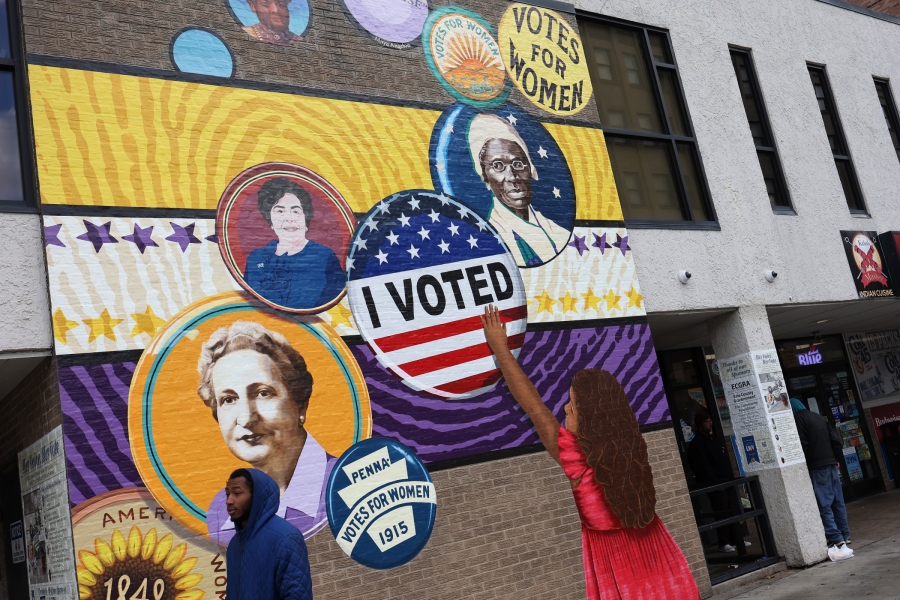
A massive gender gap has been evident in poll after poll of this election — a significant trend that underscores the pivotal role women could play this November.
Most recently, a late October Quinnipiac survey of Michigan found 57 percent of women in the state back Vice President Kamala Harris, while 40 percent of men did the same. Conversely, 56 percent of men backed former President Donald Trump, while 37 percent of women did. That’s repeatedly been the case in national polls, too. For example, a recent poll from USA Today/Suffolk University found that Harris had a 16-point gap in the support that she saw from men and women.
“It’s the battle of the sexes, and it’s no game,” Quinnipiac pollster Tim Malloy said in a statement. “There is a glaring gap in Michigan and Wisconsin between the number of women supporting Harris and the number of men supporting Trump.” In Quinnipiac polls conducted in five of the seven key swing states throughout October, Harris had a significant lead among women, while Trump saw a comparable advantage among men in those same places. (Quinnipiac has not released October results for Nevada and Arizona.)
Women supporting Democrats over Republicans isn’t a new phenomenon: Members of the group have been more likely to support the party than men since the 1980s, and this political divide has only grown over time. This time around, though, that split could have major implications for the election outcome due both to how tight the race is, and other demographic shifts.
Related:
- 3 theories why Democrats have lost support among Black men
According to recent polls, Democrats seem to be losing support among groups they’ve counted on in the past, like Black men and Latino men. Those losses could be made up by boosting turnout among women, particularly since women are more likely to vote than men, and historically do so in larger numbers.
“The women’s vote will be decisive this election,” Katherine Tate, a Brown University political scientist, said. “If Harris wins, it will be because women elected her.”
The gender gap is a sign of the inroads Democrats have made over time
Women have backed Democrats by a significant margin in multiple cycles now. In 2020, President Joe Biden won 55 percent of women voters, while Trump won 44 percent, and in 2016, former Secretary of State Hillary Clinton won 54 percent of women voters, while Trump won 39 percent, according to Pew Research Center. If the actual outcome approaches the figures that pollsters are seeing, Democrats could well maintain these margins.
Part of Democrats’ growth with women comes from ideological shifts: A higher proportion of women across all age groups are now identifying as liberal, compared to two decades ago, according to a Gallup survey published in February. And younger women between the ages of 18 to 29, especially, are one of the groups now far more likely to identify as liberal than they were in the past. Gallup found 40 percent of young women identified as liberal in 2023 compared to 29 percent in 1999.
While the left is adding women, it’s gaining few men, however. In that same 24-year timeframe, Gallup found the proportion of men who identify as liberal across age groups has stayed relatively unchanged: Just 25 percent of young men identified as liberal in 2023, only 1 percentage point more than in 1999.
Women’s leftward shift has been driven by a combination of factors, including opposition to misogynistic rhetoric from GOP leaders and allegations of sexual misconduct faced by prominent political figures — like Trump, who’s the subject of more than 20 accusations of sexual assault and misconduct, including a new allegation this week.
Social movements like the #MeToo movement raised awareness of sexual misconduct and harassment in 2017. And women became more involved politically in the wake of Trump’s election, organizing via demonstrations like the Women’s March and running for elected office in record numbers.
Democrats’ stances on social issues including reproductive rights, and the outrage over the Supreme Court decision overturning Roe v. Wade in 2022 have also resonated with some women. Trump was responsible for appointing the justices who led the overturn of Roe, and has bragged about his role in doing so. Democrats, meanwhile, have fashioned themselves as the party dedicated to defending reproductive health care.
Since the 1980s, many women have increasingly viewed Democrats as operating in their economic interest too, Roosevelt Institute historian Suzanne Kahn wrote for Time. That idea can be traced back to President Ronald Reagan’s decision to cut social benefits like Social Security and welfare, a reduction that disproportionately harmed women, Kahn wrote. And it’s since been solidified by efforts by Presidents Barack Obama and Bill Clinton to pass laws addressing the gender wage gap and establishing family leave.
“Women believe that they or their family may need government help or protection,” Democratic pollster Celinda Lake says. “Men think it’s a good day when the government doesn’t do anything bad to you.”
And Democrats have been able to take advantage of the power of representation as the party has diversified as well. The Democratic Party itself has become more representative of women in recent decades, and made a successful push for the recruitment and promotion of women candidates, something Republicans are still catching up to.
Related:
- The paradox at the heart of the most diverse Congress ever
In the House, for example, 43 percent of Democratic lawmakers are women, while 15 percent of Republican lawmakers are women. The party’s efforts have also led to two women at the top of Democrats’ presidential ticket, including Harris, something many Democratic voters have expressed excitement about.
Women’s leftward shift has calcified into party affiliation with Democrats, Lake says, and that could have major consequences this election cycle.
Currently, a number of swing state polls are even between the two presidential candidates — and boosting support with women could be what pushes Harris over the top.
“In close races the formula for victory is to win women by more than you lose men,” Lake tells Vox.
Source: vox.com






